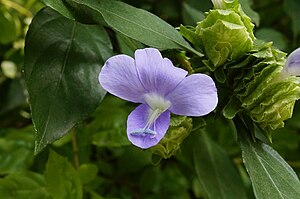Note: This is a project under development. The articles on this wiki are just being initiated and broadly incomplete. You can Help creating new pages.
Difference between revisions of "Barleria strigosa - Nīlajhiṇṭī"
| (5 intermediate revisions by the same user not shown) | |||
| Line 1: | Line 1: | ||
[[File:Barleria strigosa 2820.jpg|thumb|right|''Nīlajhiṇṭī'']] | [[File:Barleria strigosa 2820.jpg|thumb|right|''Nīlajhiṇṭī'']] | ||
| + | |||
'''Nīlajhiṇṭī''' consists of root of Barleria strigosa. It is a tall herb which is distributed throughout the upper gangentic plain and southern parts of India. | '''Nīlajhiṇṭī''' consists of root of Barleria strigosa. It is a tall herb which is distributed throughout the upper gangentic plain and southern parts of India. | ||
==Uses== | ==Uses== | ||
| Line 33: | Line 34: | ||
==Identification== | ==Identification== | ||
===Leaf=== | ===Leaf=== | ||
| − | {{Leaf|Simple|Opposite| Petiole brownish yellowish strigose and 0.7–2.5cm | + | {{Leaf|Simple|Opposite| Petiole brownish yellowish strigose and 0.7–2.5cm.}}<ref name="Leaf"/> |
===Flower=== | ===Flower=== | ||
| − | {{Flower|Bisexual|Terminal spikes| | + | {{Flower|Bisexual|Terminal spikes|Pink-violet||Flowers in terminal dense spikes and in axillary to 5 cm.}} |
===Fruit=== | ===Fruit=== | ||
| Line 52: | Line 53: | ||
==How to plant/cultivate== | ==How to plant/cultivate== | ||
<ref name="How to plant/cultivate"/> | <ref name="How to plant/cultivate"/> | ||
| + | |||
| + | ==Season to grow== | ||
| + | <ref name="Season to grow"/> | ||
| + | |||
| + | ==Required Ecosystem/Climate== | ||
| + | <ref name="Required Ecosystem/Climate"/> | ||
| + | |||
| + | ==Kind of soil needed== | ||
| + | Well drained soil<ref name="Kind of soil needed"/> | ||
==Commonly seen growing in areas== | ==Commonly seen growing in areas== | ||
| Line 58: | Line 68: | ||
==Photo Gallery== | ==Photo Gallery== | ||
<gallery class="left" caption="" widths="140px" heights="140px"> | <gallery class="left" caption="" widths="140px" heights="140px"> | ||
| + | |||
File:Barleria strigosa 2681.jpg|Flower and leaves | File:Barleria strigosa 2681.jpg|Flower and leaves | ||
File:Barleria strigosa DSC 6904.JPG|Flower | File:Barleria strigosa DSC 6904.JPG|Flower | ||
| Line 67: | Line 78: | ||
<references> | <references> | ||
<ref name="chemical composition">[http://gbpihedenvis.nic.in/PDFs/Glossary_Medicinal_Plants_Springer.pdf Chemical composition]</ref> | <ref name="chemical composition">[http://gbpihedenvis.nic.in/PDFs/Glossary_Medicinal_Plants_Springer.pdf Chemical composition]</ref> | ||
| − | <ref name="Leaf">[https://indiabiodiversity.org/species/show/250255 | + | <ref name="Leaf">[https://indiabiodiversity.org/species/show/250255 Morphology]</ref> |
| − | <ref name="How to plant/cultivate">[ | + | <ref name="How to plant/cultivate">[Cultivation detail]</ref> |
| + | |||
| + | <ref name="Kind of soil needed">[http://www.missouribotanicalgarden.org/PlantFinder/PlantFinderDetails.aspx?taxonid=275273&isprofile=0&= Kind of soil needed]</ref> | ||
</references> | </references> | ||
Latest revision as of 17:07, 3 November 2020
Nīlajhiṇṭī consists of root of Barleria strigosa. It is a tall herb which is distributed throughout the upper gangentic plain and southern parts of India.
Contents
- 1 Uses
- 2 Parts Used
- 3 Chemical Composition
- 4 Common names
- 5 Properties
- 6 Habit
- 7 Identification
- 8 List of Ayurvedic medicine in which the herb is used
- 9 Where to get the saplings
- 10 Mode of Propagation
- 11 How to plant/cultivate
- 12 Season to grow
- 13 Required Ecosystem/Climate
- 14 Kind of soil needed
- 15 Commonly seen growing in areas
- 16 Photo Gallery
- 17 References
- 18 External Links
Uses
Serious catarrhal infections, Boils, Snake bites, Sores.
Parts Used
Chemical Composition
The plant gave beta-and gammasitosterol. [1]
Common names
| Language | Common name |
|---|---|
| Kannada | |
| Hindi | |
| Malayalam | |
| Tamil | |
| Telugu | |
| Marathi | NA |
| Gujarathi | NA |
| Punjabi | NA |
| Kashmiri | NA |
| Sanskrit | |
| English |
Properties
Reference: Dravya - Substance, Rasa - Taste, Guna - Qualities, Veerya - Potency, Vipaka - Post-digesion effect, Karma - Pharmacological activity, Prabhava - Therepeutics.
Dravya
Rasa
Guna
Veerya
Vipaka
Karma
Prabhava
Habit
Identification
Leaf
| Kind | Shape | Feature |
|---|---|---|
| Simple | Opposite | Petiole brownish yellowish strigose and 0.7–2.5cm. |
Flower
| Type | Size | Color and composition | Stamen | More information |
|---|---|---|---|---|
| Bisexual | Terminal spikes | Pink-violet | Flowers in terminal dense spikes and in axillary to 5 cm. |
Fruit
| Type | Size | Mass | Appearance | Seeds | More information |
|---|---|---|---|---|---|
| Capsule | 1.4–1.8 x ca. 0.5 cm | Capsule is ellipsoid, glabrous, 1.4–1.8 x ca. 0.5 cm, shining, four-seeded. |
Other features
List of Ayurvedic medicine in which the herb is used
Where to get the saplings
Mode of Propagation
How to plant/cultivate
Season to grow
Required Ecosystem/Climate
Kind of soil needed
Well drained soil[6]
Commonly seen growing in areas
[[:Category:Herbs that are commonly seen in the region of |]], [[:Category:Herbs that are commonly seen in the region of |]].
Photo Gallery
References
- ↑ Chemical composition
- ↑ Morphology
- ↑ [Cultivation detail]
- ↑ Cite error: Invalid
<ref>tag; no text was provided for refs namedSeason to grow - ↑ Cite error: Invalid
<ref>tag; no text was provided for refs namedRequired Ecosystem/Climate - ↑ Kind of soil needed
External Links
Categories:
- Pages with reference errors
- Ayurvedic Herbs known to be helpful to treat Serious catarrhal infections
- Ayurvedic Herbs known to be helpful to treat Boils
- Ayurvedic Herbs known to be helpful to treat Snake bites
- Ayurvedic Herbs known to be helpful to treat Sores
- Herbs with Flower used in medicine
- Habit - Evergreen shrub
- Index of Plants which can be propagated by Seeds
- Herbs that are commonly seen in the region of
- Herbs
- Acanthaceae



